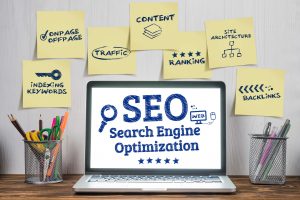SEO
In order to understand how SEO perform, it’s important to have a basic understanding of how search engines work. Search engines use crawlers (also known as spiders or bots) to collect information across the internet to populate their latest databases, called “indexes”. Crawlers starts from a known web page and then follow links from that page to other pages. Some basic forms which are categorized as On page, OFF page, technical, keyword research, backlinks etc.

For example, if a page Google already indexed on Patagonia.com on the topic of consumed clothing features internal links to further pages on the site for used jackets, used hiking boots, and consumed flannel shirts, Google can crawl to those pages via the links offered. The content of the discovered page, and the context of the links the crawler followed from Patagonia to own websites, aid Google understand what the page is about and how it is relevant to all of the other pages within its index.
If you occurs to be the journalist who wrote its own website article on fast fashion, the fact that a used outdoor clothing section of a
latest brand is linking to your piece is an indication to Google that there might be a relationship between the problems of fast fashion and the potential solution of buying used clothing instead of new clothing. These semantic relationships go far towards helping Google determine which results to show for each query they receive from the searching public.
Search engine optimization channels
On-Page SEO
On-site SEO refers to the practice of optimizing elements on a website, such as the content and HTML code, to improve its rankings in search engine results pages and attract more relevant traffic to the website. This is different from off-site, which involves optimizing external factors like backlinks and social media signals.
Off-Page SEO
Off-page SEO, also called off-site, is the practice of improving a website’s search engine ranking by optimizing factors outside of the website itself. This can be done by building high-quality backlinks, promoting the website on social media, and other forms of online marketing. The goal is to increase the website’s authority, reputation, and relevance in the eyes of search engines, which can result in higher search engine rankings and more organic traffic to the website. Guest blogging is a common off-page technique used for building backlinks. Important terms of OFF page are indexing, crawling, sitemaping, backlink, keyword research etc
Technical SEO
Technical SEO involves making website optimizations that help search engines crawl and index a website more easily, thereby improving its search engine ranking. This includes tasks such as optimizing site load time, ensuring that robot.txt files are properly configured, and setting up redirects correctly.

SEO Obstacles
This section of the blog will expand on the disadvantages of Search Engine Optimization. Implementing effective strategies and achieving significant results can be a time-consuming process. It requires thorough keyword research, content optimization, link building, and continuous monitoring and adjustments. SEO is an ongoing effort that demands dedication and patience. It may take several months or even longer to see noticeable improvements in organic traffic and search rankings. This time investment can be challenging for businesses seeking immediate results or operating in highly competitive industries.
Constant algorithm changes
Search Engines regularly update algorithms to improve search results’ relevance and user experience. These algorithm changes can have a significant impact on a website’s rankings, even if it has been optimized effectively. SEO professionals must stay updated with these changes, adapt their strategies, and ensure compliance with the latest guidelines. Constantly evolving algorithms can make a challenging task, requiring ongoing learning and adjustments to maintain and improve search rankings.
Initial investment
Implementing SEO strategies often requires an initial investment. Businesses may need to allocate resources for hiring professionals, investing in SEO tools and software, conducting keyword research, creating high-quality content, and improving website infrastructure. The initial costs can be significant, especially for small businesses with limited budgets. It’s important to carefully consider the available resources and the expected return on investment before committing to SEO initiatives.
Competitiveness
The digital landscape is highly competitive, and many businesses are investing in SEO to improve their online presence and attract organic traffic. Achieving top rankings for highly competitive keywords can be difficult, especially for startups or businesses with limited resources. The level of competition can significantly impact the time and effort required to achieve desired results. Businesses must carefully assess their competition and develop effective strategies to stand out in the crowded online marketplace.
Best Search Engine Optimization
This section of the blog will expand on the different advantages of Search Engine Optimisation.
Increased website visibility
One of the major advantages is the enhanced visibility it brings to a website. By optimizing the website’s content, structure, and meta tags, helps it rank higher in Search Engine results pages (SERPs). When a website appears prominently in search results, it gains more exposure and attracts the attention of potential visitors. Improved visibility increases brand awareness and establishes the website as a credible source in its industry.
Higher organic traffic
SEO focuses on driving organic (non-paid) traffic to a website. By targeting relevant keywords and optimizing the website’s content, Search engine optimization attracts users who are searching for information or products related to the website’s offerings. Whenever a website ranks higher in search results, it receives a higher number of clicks, resulting in increased organic traffic. Targeted traffic has higher potential for conversions, leading to a better Return on Investment (ROI).
Cost-effective marketing strategy
Compared to other digital advertising methods, SEO is a cost-effective strategy. While there may be initial investments in hiring professionals or implementing SEO Tools, the long-term benefits outweigh the costs. Unlike paid advertising, focuses on organic traffic and does not require continuous payments for each click or impression. Once a website’s rankings improve, it can sustain its visibility without additional expenses.
Long-term results
One of the remarkable aspects of SEO is its ability to deliver long-term results. While efforts require continuous monitoring and adjustments, the foundation built through effective optimization can provide sustainable visibility and traffic over time. Once a website establishes a strong online presence, it becomes more challenging for competitors to outrank it. This sustained visibility and organic traffic contribute to the website’s authority and enhance its credibility in the eyes of Search Engines and users.
Targeted audience
Search engine optimization enables businesses to target specific audiences based on their search intent. By optimizing the website’s content and meta tags with relevant keywords, businesses can attract users actively seeking information or solutions related to their industry. This targeted approach multiplies the chances of attracting qualified leads and potential customers. When a website provides valuable and relevant content to its target audience, it fosters trust, credibility, and customer loyalty.
SEO goals
SEO, or search engine optimization, is the lowest-cost and most effective ways to drive traffic to your website. There stands for search engine optimization. It is the process of improving your website to increase visitors from Google, Microsoft Bing and other search engines, whenever people search for
- Products you sell.
- Services you provide.
- Information on topics in which you have expertise or experience.

SEO promotion
It takes a noticeable amount of time to see results with SEO. So, treat as part of an ongoing project that will never be complete. Your timeline for seeing results will also depend on how new your site is, how good your SEO strategy is, and how consistent you are in implementing your tactics.
If you have all that going for you, expect to start seeing results within four months to a year. Remember that your website’s visibility and rankings will be heavily influenced by who your competitors are and what keywords you’re trying to rank for. To know if you’re making progress, track results and refine your strategy as data comes in. Over time, you’ll see it pay off. Prioritize sustainability over speed. And you’ll enjoy the rewards for longer.

